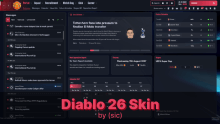
How to utilize staff as injury precaution and faster recovery
Written by TalleryThe backroom staff you have supporting you also play a very big part in dealing with injuries, especially your physios and fitness coaches.
When a player gets injured, you get a report from your head physio. Your head physio is key as he is the one compiling injury reports. The worse he is (lower stats), the less accurate the report will be, such as the severity of the injury and the time needed for recovery, which is rather crucial. The physios also play a huge part. Once the head physio has compiled his report, he hands it over to his right-hand men (or women) to try and get the players back to full fitness. The better your physios are, the quicker the injury will be healed, making the player available to you as quickly as possible. Also keep in mind that having more physios means healing time will be decreased when you are dealing with multiple injuries, as it will be possible for them to spend more time caring for each individual injury.
| Staff Attributes and Training Ratings Explained
Learn what each staff attribute means, which are the key attributes for each training area and for each club job. |
Once your player is fit enough to train, he will be handed over to your fitness coaches, who will oversee your player’s return to full fitness. The better your fitness coaches are, the less time it takes for your player to return to full fitness. However, fitness coaches also play another important role. After a game, they are given the task of making sure your players are fit. The fitter the players, the more unlikely they are to sustain an injury in training or in a match, having a higher fitness level to start with.
That being said, your backroom staff are not magicians and will not prevent every injury – you will get the occasional bad tackle that will twist a knee or the odd pulled hamstring that will keep your player out for a few months, but your backroom staff can go a long way to help sort out these nasty injuries when they do occur.
Points to take away:
- head physio is key as he is the one compiling injury reports
- the better your physios are, the quicker the injury will be healed
- better fitness coaches need less time until your player returns to full fitness
2. Selling your injury prone players
3. Intensity of training schedules
4. Choosing your best XI with fitness and condition in mind
5. Protecting your injury prone players
6. Having adequate cover to battle through injuries
7. Making subs during a match to prevent injury
8. Handling resting days
9. How to utilize staff as injury precaution and faster recovery
10. Important attributes that may affect the chances of getting injured
11. The impact of upgrading training and youth facilities









![FM24 2025-26 Real Fixture & Results (Start in 2025) [29-10-2025]](https://www.fmscout.com/datas/users/realresult_artv2_257759.png)


Discussion: Keeping Injuries Under Control on Football Manager
1 comments have been posted so far.
1, match instruction: "Get stuck in" - the stonger your player tackle the opposition the bigger the chance that he will hurt himself too.
2. individual opposition tackling instruction: "Hard" - the more opposition players are set to be tackled hard the more injuries your own players will pick up. Especially if you consider that the more attacking the position is usually the worse the tackling ability of the player is. I do not ask my midfilders and wingers to tackle opp. midfilders/wingers hard any more and their injuries substantially decreased.
3, level of fitness coaching: higher aerobic coaching helps to prevent injuries to occur.
and depending on how do you interpret what is already written in the article (was it aimed only at pre-season or not):
4, general training level during season: setting it higher (i.e. above average) increases the likelyhood of getting injured in training